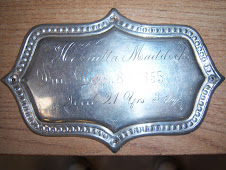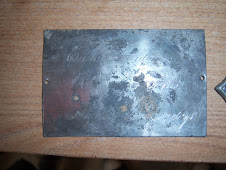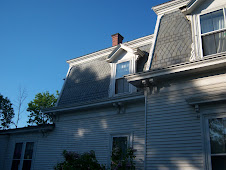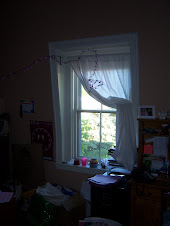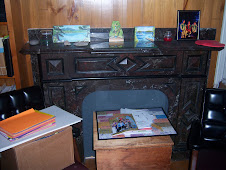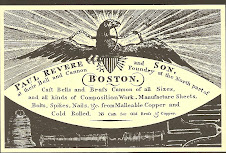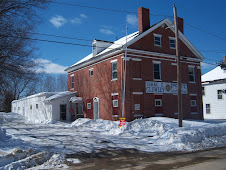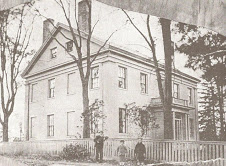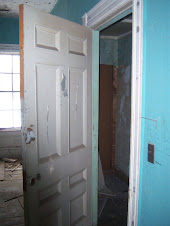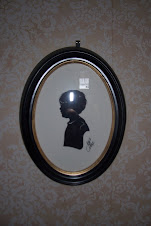Captain James Weeks, Professor Emeritus at Maine Maritime Academy, used a surgeon's skill to cut through the events that engulfed the passengers of the ill-fated ship Titantic on April 15th of 1912. Utilizing models that he had created, schematics and disgrams, Captain Weeks showed in detail how the luxury liner hit the iceberg that was to her doom and how the North Sea engulfed the ship until finally, in the early morning of the 15th, she slipped below the waves with a loss of life of over 1500 people. He explained how the lifeboats were half empty and how the ship, Carpathia, heroically led the rescue of those who survived.
There are some passenger ties to Maine. Jack Thayer, a teenager on board, was ultimately proved to be correct in his assertion that the ship broke in two despite the insistence by a ship's officer that it hadn't. Jack Thayer's granddaughter presently lives in Maine. In addition there was a member of the audience whose grandmother was a survivor. He recounted how the half-empty lifeboat would not return for floundering passengers either because the officer was afraid that the sinking ship would pull her under or because the scrambling of the boarding passengers might capsize her.
Captain Weeks said that there were two Titantics---the real Titantic and the Hollywood Titantic. No matter which Titantic you follow, there is the adventure and heroism and sacrifice of over 2200 human beings on that night to remember.
Sunday, November 15, 2009
Marketing the Historical Society in a New Era, by Robert Schmick
Having visited more than my fair share of museums, historical societies, and historic houses, I have become aware of some of the challenges that especially smaller institutions face in the wake of ever increasing competition for the time of their potential audiences. Not only has television, mass media, and electronic media changed the publics’ recreational activities, but for-profit corporations have taken on an increasing role in developing exhibitions, cultural programming, and edutainment in more densely populated areas that continue to overshadow and threaten especially small institutions with small budgets. This competition has made it necessary for small cultural institutions like the local historical society to focus directly on marketing strategies. Marketing, with its traditions of competition, has often been seen by the museum community as something for them to resist, but, such strategies can make an institution greater at serving a larger portion of their community.
Successful marketing strategies are founded on an understanding of the public and their needs, or perceived needs. Small institutions, like the local historical society, need to step up to the plate and deliver new and attractive ways of presenting themselves. They must drive the point home that they are the real thing, a place where meaningful objects and trustworthy information can be found and serve a role in their lives and their community. In doing this they negate all the fears about taking on the agenda of marketing. They also need to embrace history of more than the elite of the past, present other periods in history than merely the distant past, and, finally, take on the untraditional role of documenting and presenting their community’s more recent past through the mediums of our own time---digital photography and audio in order to more effectively disseminate the information they have, namely much of their collections that are in storage for long periods of time, and become more relevant to generations that have embraced new digital media.
Taking on the point of view of visitors, or potential visitors, may mean that the local historical society must transcend merely the historical narratives of the 17th-19th centuries and seek to satisfy the current demand for twentieth century nostalgia by baby boomers, Gen-Xers, and the like. This could be a strategy that will result in drawing more people into the institution’s fold for further growth and initiate some needed enthusiasm among greater numbers for the historical society’s existing collections.
In saying this, I am reminded of institutions in which very dedicated individuals scratch their heads and wonder why they have so few younger and middle aged among their membership. Of course, this is a demographic that is busy raising families and working, but they do have leisure time, and the question the historical societies should be asking is how do we make our institution relevant to this group and make them want to spend that leisure as a visitor to our facility or involved in the collecting of local history and its dissemination through education.
What might be some of the specific marketing strategies that would make these historical societies more relevant to the lives of more? The Andover Historical Society (AHS) in Andover, Massachusetts has sought to reinvent how their community members come to know about what they offer. Not long ago they struck upon the idea of organizing a farmers’ market where one no longer existed. Small farms have sprung up in increasing numbers in the past few decades in this suburban community not far from Boston. A local high school student actually sparked the idea when she contacted AHS and asked whether there were any markets in the area to sell garden produce. AHS sent out feelers about the possibility of them creating a market on the small village lot that they own, and many local farmers were ecstatic about the idea.
The Historical Society provided rental space for these local farmers right next to the historical house they maintain. This situation has allowed for this institution to participate in the making of local history rather than merely preserving the long-ago past. This scheme not only resulted in added revenues but renewed interest in the historical society. As people came out to buy produce, they seized the opportunity to walk the grounds, ask questions about the historic house, and visit it. The historical society used the opportunity of having the public on their grounds on a regular basis for the purpose of buying produce to provide outdoor programming and events more frequently. There was significant free press coverage through this arrangement as well.
Through this scheme this historical society has attracted a whole new demographic to their membership that includes young families. Amongst this new membership many admitted that they never knew about the historical society before or had heard of it concluding that it simply wasn’t for them. Prior to this phenomenon, membership consisted almost exclusively of senior citizens who were largely interested in seeking genealogical information from the historical society’s research facilities. The farmers’ market also served thematically the 19th century offerings of the historic house; workshops in traditional crafts were eventually developed to coincide with market days.
Historical societies have other opportunities of making a greater connect with the public. Other opportunities might include providing “edutainment” like summer film festivals that include discussion forums. Viewing could be offered outdoors. With the number of local cable channels available today small museums might present some of their collection holdings in televised exhibits, which may include simply having a curator or scholar talk about an artifact that stands before them. Video tours of historical houses and sites and re-enactments could be the stuff of such cable programming.
Digital videotaping has made such a possibility affordable. Programming could also be assisted by cooperative partnerships with local schools, colleges, and budding historians and media production professionals. It seems logical that a local historical society could market itself by taking a more active role in the technologies that pose a threat to their own survival as a strong competitor for the time of the public.
The historical society could establish greater relevancy in the publics’ lives by actively participating in the current documentation of their community for future generations. How about collecting artifacts and narratives from more recent history rather than waiting until they become a rarity or nonexistent? A community’s history is a complex fabric of individual and group experiences so something like a reunion of local amateur garage bands from the 60s, 70s, and 80s might serve to attract more to the cause and mission of the historical society. Something as unique as re-uniting such bands and having them play for the community might be the lengths the historical society has to go to survive, for we have to ask ourselves who is it that is going to be preserving our community’s history after we’re gone? What will become of this chapter in history in an age of few letter writers and a preference for the extraordinary by the news gathering media of our time over the more commonplace experiences of us all. Will the unique character of our community survive for future generations to know and appreciate when so little of it is destined to be preserved?
Historical societies have an obligation to preserve our more recent history now. Broadening the scope of the artifacts and narratives collected and making use of digital media, which makes it possible to store huge amounts of information in a very small place that can be disseminated to the whole world, is among the important steps to take in marketing the historical society to more of the public. By doing this we can better insure that there will be someone to inherit this institution and meet the responsibility of both preserving the past and sharing it with future generations.
Robert Schmick is the Museum Director of The Curran Homestead; this position was made possible by a Davis Family Foundation grant. As a teacher of English language and literature for nearly 20 years, Schmick became interested in using archival and other primary source materials in writing curriculums. He received a Ph.D. from New York University in Arts and Humanities Education; his dissertation is entitled "A Wilderness For All: The Transmuting and Transmitting of Wilderness Imagery by Print Media and Material Culture for Antebellum America." He also received a Professional Certificate in Museum Studies and Administration from Tufts University that included an internship at the Addison Gallery of American Art at Phillips Andover. He has served as the Volunteer Director of Education for the Curran Homestead for the past year.
Successful marketing strategies are founded on an understanding of the public and their needs, or perceived needs. Small institutions, like the local historical society, need to step up to the plate and deliver new and attractive ways of presenting themselves. They must drive the point home that they are the real thing, a place where meaningful objects and trustworthy information can be found and serve a role in their lives and their community. In doing this they negate all the fears about taking on the agenda of marketing. They also need to embrace history of more than the elite of the past, present other periods in history than merely the distant past, and, finally, take on the untraditional role of documenting and presenting their community’s more recent past through the mediums of our own time---digital photography and audio in order to more effectively disseminate the information they have, namely much of their collections that are in storage for long periods of time, and become more relevant to generations that have embraced new digital media.
Taking on the point of view of visitors, or potential visitors, may mean that the local historical society must transcend merely the historical narratives of the 17th-19th centuries and seek to satisfy the current demand for twentieth century nostalgia by baby boomers, Gen-Xers, and the like. This could be a strategy that will result in drawing more people into the institution’s fold for further growth and initiate some needed enthusiasm among greater numbers for the historical society’s existing collections.
In saying this, I am reminded of institutions in which very dedicated individuals scratch their heads and wonder why they have so few younger and middle aged among their membership. Of course, this is a demographic that is busy raising families and working, but they do have leisure time, and the question the historical societies should be asking is how do we make our institution relevant to this group and make them want to spend that leisure as a visitor to our facility or involved in the collecting of local history and its dissemination through education.
What might be some of the specific marketing strategies that would make these historical societies more relevant to the lives of more? The Andover Historical Society (AHS) in Andover, Massachusetts has sought to reinvent how their community members come to know about what they offer. Not long ago they struck upon the idea of organizing a farmers’ market where one no longer existed. Small farms have sprung up in increasing numbers in the past few decades in this suburban community not far from Boston. A local high school student actually sparked the idea when she contacted AHS and asked whether there were any markets in the area to sell garden produce. AHS sent out feelers about the possibility of them creating a market on the small village lot that they own, and many local farmers were ecstatic about the idea.
The Historical Society provided rental space for these local farmers right next to the historical house they maintain. This situation has allowed for this institution to participate in the making of local history rather than merely preserving the long-ago past. This scheme not only resulted in added revenues but renewed interest in the historical society. As people came out to buy produce, they seized the opportunity to walk the grounds, ask questions about the historic house, and visit it. The historical society used the opportunity of having the public on their grounds on a regular basis for the purpose of buying produce to provide outdoor programming and events more frequently. There was significant free press coverage through this arrangement as well.
Through this scheme this historical society has attracted a whole new demographic to their membership that includes young families. Amongst this new membership many admitted that they never knew about the historical society before or had heard of it concluding that it simply wasn’t for them. Prior to this phenomenon, membership consisted almost exclusively of senior citizens who were largely interested in seeking genealogical information from the historical society’s research facilities. The farmers’ market also served thematically the 19th century offerings of the historic house; workshops in traditional crafts were eventually developed to coincide with market days.
Historical societies have other opportunities of making a greater connect with the public. Other opportunities might include providing “edutainment” like summer film festivals that include discussion forums. Viewing could be offered outdoors. With the number of local cable channels available today small museums might present some of their collection holdings in televised exhibits, which may include simply having a curator or scholar talk about an artifact that stands before them. Video tours of historical houses and sites and re-enactments could be the stuff of such cable programming.
Digital videotaping has made such a possibility affordable. Programming could also be assisted by cooperative partnerships with local schools, colleges, and budding historians and media production professionals. It seems logical that a local historical society could market itself by taking a more active role in the technologies that pose a threat to their own survival as a strong competitor for the time of the public.
The historical society could establish greater relevancy in the publics’ lives by actively participating in the current documentation of their community for future generations. How about collecting artifacts and narratives from more recent history rather than waiting until they become a rarity or nonexistent? A community’s history is a complex fabric of individual and group experiences so something like a reunion of local amateur garage bands from the 60s, 70s, and 80s might serve to attract more to the cause and mission of the historical society. Something as unique as re-uniting such bands and having them play for the community might be the lengths the historical society has to go to survive, for we have to ask ourselves who is it that is going to be preserving our community’s history after we’re gone? What will become of this chapter in history in an age of few letter writers and a preference for the extraordinary by the news gathering media of our time over the more commonplace experiences of us all. Will the unique character of our community survive for future generations to know and appreciate when so little of it is destined to be preserved?
Historical societies have an obligation to preserve our more recent history now. Broadening the scope of the artifacts and narratives collected and making use of digital media, which makes it possible to store huge amounts of information in a very small place that can be disseminated to the whole world, is among the important steps to take in marketing the historical society to more of the public. By doing this we can better insure that there will be someone to inherit this institution and meet the responsibility of both preserving the past and sharing it with future generations.
Robert Schmick is the Museum Director of The Curran Homestead; this position was made possible by a Davis Family Foundation grant. As a teacher of English language and literature for nearly 20 years, Schmick became interested in using archival and other primary source materials in writing curriculums. He received a Ph.D. from New York University in Arts and Humanities Education; his dissertation is entitled "A Wilderness For All: The Transmuting and Transmitting of Wilderness Imagery by Print Media and Material Culture for Antebellum America." He also received a Professional Certificate in Museum Studies and Administration from Tufts University that included an internship at the Addison Gallery of American Art at Phillips Andover. He has served as the Volunteer Director of Education for the Curran Homestead for the past year.
Subscribe to:
Posts (Atom)

